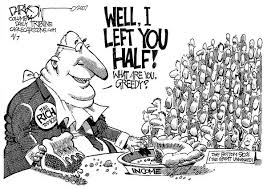International conferences on poverty and the environment come and go. The UN Millennium Development Goals are debated in many conferences. But there’s always a big elephant in the meeting room. It’s got the words “macroeconomic policy” written on its forehead. Nobody wants to talk about it. As if reducing hunger and extreme poverty, generating employment and providing health services and education have nothing to do with fiscal policy, monetary policy and financial deregulation.
To tackle these issues, macroeconomic policies for sustainability need to be established and to be able to do that, TINA (There-Is-No-Alternative) mindset and its corollary, the one-size-fits-all economic policy recipe need to be given up.
Environment policy itself should be thought of as macroeconomic policy. Monetary and fiscal policies must go through a process of redesign and redefinition in order to comply with the paramount objective of sustainability, not the other way around.
Guidelines for macroeconomic reform
Some of the most important elements that must be taken into account in order to correct the trajectory of macroeconomic policy making are as follows –
- Inequality
This is perhaps the worst enemy of sustainability. Inequality is a political event and macroeconomic policy should have as its core objective the reduction of income disparities and social inequality. Sustainability is unlikely in a world in which 48% of the total population lives on less than two and half dollars a day and these poorest groups in a society are exposed to higher environmental risks due to asymmetric vulnerability.
A macroeconomic policy for sustainability involves parting with the notion that inequality will disappear with trickle-down effects or by building social safety nets or improving targeting of anti-poverty programmes.
Social and environmental objectives need to be put at centre of macroeconomic policy-making right from the start. The fiscal policy can play a redistributive role with a truly progressive tax reform and an intelligent structure for sustainable expenditures. Price structures should be monitored to ensure that the price system does not conspire against poor agricultural products.
- Resources for sustainability
Macroeconomic policy for sustainability needs to ensure allocation of adequate flow of resources to environmental stewardship and restoration. In developing countries, fiscal policy can play a crucial role in allocating resources to the environment:
a) Tax revenues need to be increased by levying higher taxes on high income brackets, capital gains and financial transactions, but not necessarily putting fiscal pressure to the point of discouraging investment and capital formation. Levies on financial transactions exist in UK and they have not provoked capital flight.
b) The principle of generating a primary surplus is typically attained by reducing per capita social expenditures (healthcare, education, housing, etc.) instead of increasing fiscal revenues through progressive tax regimes. Thus, in the long run, this policy posture undermines the capacity of a country to attain sustainability objectives. Primary surplus policies are directly linked to debt management. The burden of external and domestic public debt weighs heavily on the developing countries, particularly open economies.
c) Although social expenditures have been curtailed, subsidies for activities in the financial sector or for energy companies or environmentally detrimental activities, such as deep-sea fishing and extractive industries have continued. These subsidies must be redirected to sustainability objectives.
Not all of the resources for environmental stewardship have to come from public sources. Other sources can be relied on:
a) Creation of incentives for firms to cover the costs of any environmental damages they cause.
b) Payments for environmental services, especially to communities that engage in healthy environmental stewardship e.g. small scale agriculture that provides services by maintaining healthy soil management and water administration practices as well as bio diversity conservation.
- Monetary policy, exchange rates and the capital account
If monetary policy is going to contribute to sustainability objectives, it needs to escape from its subordination to needs of financial capital. A key principle here is that the financial system must serve the real economy and not the other way around.
The expansionary policies are severely curtailed as inflation targeting and attracting capital flows favors high interest rates, depressing the growth and employment. It hampers environmental stewardship by restricting rates of return and rates of extraction of natural resources.
In the context of a monetary policy that incorporates sustainability objectives, a wise balance will have to be maintained between short-term rates and long-term rates that aim at fostering development. In an open-economy setting, monetary policy has to be analyzed further as interest rate and exchange rate have a crucial role to play in this.
To incorporate long-term sustainability into monetary policy, we need to restore a higher degree of heterogeneity. This can be done by re-regulating the banking sector, by recovering some social control over finance and money supply.
- Financial regulation
The recent economic crisis was perceived as originating in the financial sector and to prevent this from happening again, a robust regulatory framework is suggested. Reforms required in the financial system at the national level are as follows:
a) All off-balance-sheet transactions must be outlawed. In 2007 and 2008, Lehman Brothers Holdings, Inc used these off-book operations to understate its leverage and deceived shareholders about its ability to withstand losses. These unfair business practices that are not strictly illegal may accelerate or intensify environmental degradation by selling natural assets and liquidifying them if that is what is needed in corporate strategy.
b) Regulatory arbitraging must come to an end. The shadow banking system with minimal regulatory oversight distorts investment flows and creates opportunities for speculative pursuits.
c) Financial re-regulation needs to move beyond micro-prudential considerations and take macroeconomic and sustainability considerations into account. In Brazil the combination of financial deregulation and retrenchment of public spending (the result of a fiscal policy geared to generating a primary surplus) led to the expansion of large-scale commercial soybean production, the displacement of ranching and finally, increased deforestation in the Amazon basin.
d) Speculative ‘investments’ and hedging practices in futures and commodity markets need to be constrained. These practices were the main drivers of the price hikes that affected the world economy and the food security of millions in 2007/08. This can be done through direct regulations or through a special tax on transactions in these markets above certain limits.
Thus, natural resources must not be seen as capital assets belonging to a general portfolio because when they are stamped with a monetary sign and become objects of speculation, trouble is just around the corner as they can be acquired with leveraged money with a view to appreciation rather than a long-term conservation. In today’s financial markets, where regulation is weak and the innovative capacity of money managers outstrips the supervising capacity of regulators, recommending that natural resources and the environment be treated ‘just like another asset’ is a recipe for disaster.


Leave a Reply